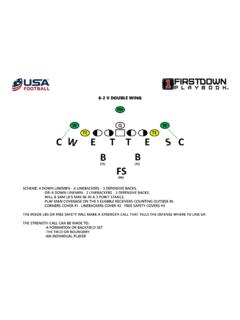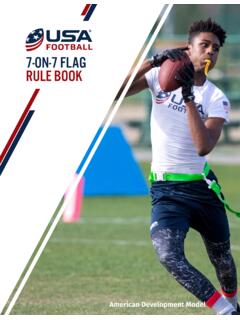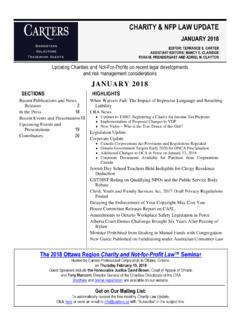Transcription of NATIONAL PRACTICE GUIDELINES FOR YOUTH ... - USA Football
1 NATIONAL PRACTICE GUIDELINES FOR YOUTH TACKLE FOOTBALLBACKGROUNDUSA Football is committed to advancing player safety to protect the health and well-being of every child. In addition to coaching education, a key element of player health and safety is the responsibility of all coaches to conduct organized practices and teach proper fundamentals in a safer environment. There are approximately 9,300 YOUTH tackle Football organizations in the United States. Within these are approximately million young athletes who play and 400,000 adults who coach. PURPOSEThe purpose of these GUIDELINES is to provide YOUTH Football organizations (players age 6 to 14) with recommendations to establish consistent methods designed to limit the chance for injury during structured PRACTICE sessions.
2 This document provides YOUTH Football commissioners and coaches with heat acclimatization GUIDELINES , clear definitions of contact and recommendation on the number of practices per week and time limits on player-to-player full contact. There is much to be learned about helmet impacts in YOUTH sports. We remain committed to adopting the best evidence-based practices . We recognize that even with the latest research available, there is no clear consensus in this area. Accordingly, we will update these recommendations and GUIDELINES in accordance with the evidence. Ideally, this emerging data will help us understand the potential for long-term adverse cognitive, emotional and/or neurological effects from concussions and/or other repeated head contact without associated symptoms.
3 Based on what is known about concussions today, the guiding principles in developing these recommendations were to reasonably limit head contact and thus concussion 1 Implementing a preseason YOUTH Football heat acclimatization periodReported cases of exertional heat stroke (EHS) currently rank among the top-three causes of sport participation fatalities. Setting mandatory GUIDELINES for heat acclimatization provides a vital standard to protect athletes against exertional heat illnesses and possibly save lives. The majority of EHS cases occur during summer workouts when athletes are unprepared to cope with environmental conditions and physiological demands placed upon them.
4 Heat acclimatization GUIDELINES recommend that athletes be introduced slowly to environmental stresses during PRACTICE sessions, resulting in a lowered risk for EHS. These GUIDELINES call for a two-week period (10-14 days) when coaches gradually increase the length and intensity of PRACTICE and the amount of equipment that can be worn. At all times, athletes should have access to fluids and have periods of rest throughout a include: 1. At no time throughout the preseason or regular season should teams PRACTICE more than once per day (No two-a-day practices ). Teams should be allowed to PRACTICE a maximum of four times per week during the During PRACTICE days 1 and 2 of the heat-acclimatization period, no more than 90 minutes of PRACTICE are allowed, a helmet should be the only protective equipment permitted.
5 No form of player-to-player contact should occur during the first two practices . 3. During PRACTICE days 3 and 4, two hours of total PRACTICE time is allowed. Only helmets and shoulder pads should be worn. No full-contact drills should be allowed. USA Football defines full-contact as drills being run at Thud and Live tempo. Coaches are encouraged to limit player-to-player contact up to Control using USA Football s Levels of Contact. 4. On PRACTICE days 5 and 6, two hours of PRACTICE time is allowed which would occur within the second week of a YOUTH organization s preseason schedule according to these GUIDELINES .
6 Teams have the option to wear full pads and full contact drills can begin and should be utilized within the recommended time allocation discussed below. 5. If a PRACTICE is interrupted by inclement weather or heat restrictions on any of the PRACTICE days, the PRACTICE should resume once conditions are deemed safe. 6. On days when environmental conditions (heat index or WBGT) are extreme, modifications should be made to the work-to-rest ratio (to allow for cool-down periods and rehydration) or rescheduled to cooler parts of the day ( before 10am or after 6pm). GUIDELINE 3 GUIDELINE 2 Ensure all YOUTH coaches understand the definition of full contact Full-contact drills should be limited during the preseason and regular season as the number of exposures may increase the chance for injury to YOUTH players.
7 For purposes of these GUIDELINES , full-contact consists of both Thud and Live Action using USA Football s definitions of Levels of Contact. Rationale: By definition, Thud involves initiation of contact at full speed with no predetermined winner, but no take-down to the ground. Initial contact, particularly with linemen, is just as physical with Thud as with Live Action. USA Football recognizes that Live Action likely carries a higher injury risk to the body than does Thud. The first three levels of USA Football Levels of Contact Air, Bags, and Control are considered no or controlled-contact, and thus no limitations are placed on their use in number of team practices and amount of full contact drills per weekPreseason Recommendation Following the preseason acclimatization period, it is recommended YOUTH teams conduct no more than four practices per week.
8 Coaches are to limit the amount of full-contact to no more than 30 minutes per day and no more than 120 minutes per week. No two-a-day practices should be allowed at any point throughout the preseason. Rationale: USA Football recognizes preseason practices may require more full-contact time than practices occurring in the regular season to allow for teaching fundamentals with sufficient repetition to prepare for the season. Coaches are encouraged to introduce contact through a progressive manner to ensure they are using proper technique before full-contact (Thud & Live Action) drills are Season Recommendation Once the regular season begins and games commence, USA Football recommends the number of practices per week is decreased to three to account for the weekly game.
9 Coaches are to limit the amount of full-contact to no more than 30 minutes per day and no more than 90 minutes per : At this point in the season, games have begun and full-contact exposure rates have increased on a weekly basis for players. To account for this, the recommendation to eliminate one PRACTICE per week and decrease the amount of time dedicated to full-contact drills decreases the number of exposures per need to use a PRACTICE plan and assign a level of contact for every drill according to USA Football s Level of Contact chart USA Football defines contact using its Levels of Contact chart (see below) to help coaches assign a level of resistance for each drill period within their PRACTICE plan.
10 Properly employing the levels of contact during a Football PRACTICE is an important skill for YOUTH coaches to learn. This is completed by adjusting the distance between players, the speed at which they conduct a drill and modifying the winner of a drill. In doing this, coaches can better accomplish specific teaching objectives during practices and decrease the chance for when to teach, when to compete and when to adjust contact promotes a better experience for players and coaches. Proper usage of the Levels of Contact system will help players perform their contact skills at a high level while instilling confidence.










